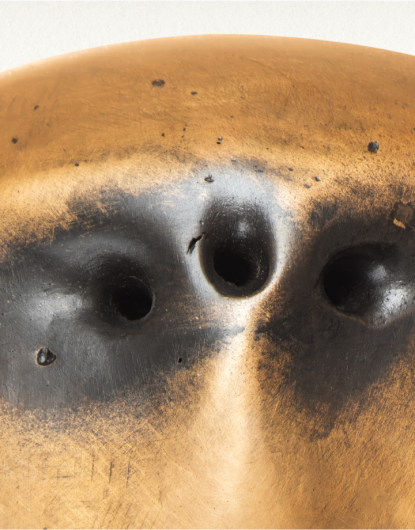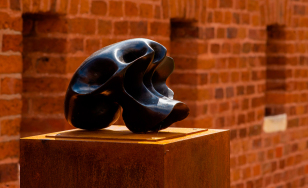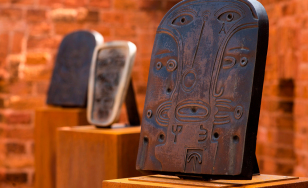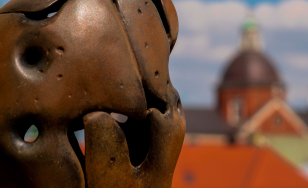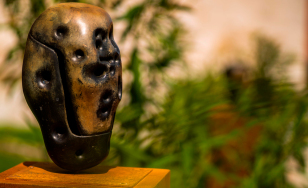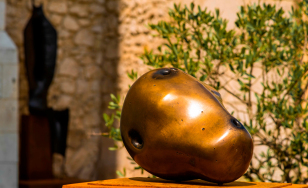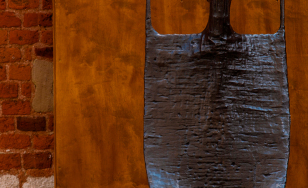Beksiński: Sculptures
April 27–October 10, 2023
The landmark exhibition Beksiński: Sculptures in the Royal Gardens at Wawel Castle unveils a nearly unknown side of Polish avant-garde artist Zdzisław Beksiński – Bekśiński the sculptor. Fourteen intriguing works, including the large-scale sculptures Macbeth and Hamlet, acquire new meaning in their Renaissance setting. In this exhibition the brightness and natural exuberance for which the Wawel gardens are famous, encounter the darkness and anxiety expressed in Beksinski’s works, which to this day retain an air of mystery.
The curators of the exhibition are Małgorzata and Marcin Gołębiewski of the East of Art Foundation in Krakow.
The exhibition opening will take place on 26 April at 6 p.m. The event will be accompanied by music – Beksiński’s favorite works. All are welcome!
The landmark exhibition Beksiński: Sculptures in the Royal Gardens at Wawel Castle unveils a nearly unknown side of Polish avant-garde artist Zdzisław Beksiński – Bekśiński the sculptor. Fourteen intriguing works, including the large-scale sculptures Macbeth and Hamlet, acquire new meaning in their Renaissance setting. In this exhibition the brightness and natural exuberance for which the Wawel gardens are famous, encounter the darkness and anxiety expressed in Beksinski’s works, which to this day retain an air of mystery.
The curators of the exhibition are Małgorzata and Marcin Gołębiewski of the East of Art Foundation in Krakow.
The exhibition opening will take place on 26 April at 6 p.m. The event will be accompanied by music – Beksiński’s favorite works. All are welcome!
Beksiński: Sculptures presents the series Heads, which consists of bronze casts – variations on the theme of the human skull. Also on view are bas-reliefs. Among the artist’s major works are casts of two poignant large-scale sculptures: Hamlet and Macbeth.
“With the open-air exhibition of Zdzisław Beksiński’s sculptures, we are continuing the tradition of holding exhibitions in Wawel’s Royal Gardens. After Józef Wilkoń and Bronisław Chromy, the time has come to present Beksiński’s intriguing oeuvre, which may surprise fans of his paintings. The exhibition in the gardens is also a unique opportunity to visit the Castle with the whole family, especially the youngest art lovers, in a friendly and relaxed atmosphere,” says Prof. Andrzej Betlej, Director of Wawel Royal Castle.
Curators Małgorzata and Marcin Gołębiewski of the East of Art Foundation in Krakow write of the objects on display: “The collection is very diverse, ranging from openwork forms, which are light, cut out, hollow, to more solid masses with numerous hollows and holes resembling multiple eye sockets. Beksiński definitely did not see sculpture as a closed form and a homogeneous solid, he experimented with its materiality. Hamlet is a figure, or rather a greatly transformed simulacrum of a human figure, stretched out, curved, unstable, which takes on the form of a throne or armchair. The broad torso provides a natural backrest, the pointed, upward-sloping knees form the shape of the seat. The scale, the slenderness and distortion of the figure, and the blackness of the patina enhance the impression of unreality. The surface of the sculpture is not as smooth as that of the heads, but instead is enriched with grooves and textural effects. Hamlet is an example of an abstract work that is at the same time a figurative work, although far removed from realism.”
The second figurative sculpture in the exhibition, created in metal in the 1960s, is Macbeth. “Suggestive and intensely affecting the viewer it illustrates how strongly the artist experienced emotions. The tragic figure kneels with arms stretched upwards, through which Beksiński achieves a strong dramatic effect. There is, as with Hamlet, a certain contrast between smoother and rougher passages.”
***
Why did Zdzisław Beksiński abandon sculpture in favor of painting? This is an open question that the curators posed while working on the exhibition: “If, in the 1960s, Beksiński had had favorable conditions, a suitable work space, a sculpture studio, and the financial resources necessary to make casts in noble materials, would he have decided to continue working in this medium? Or did he simply realize that he had achieve all he could as a sculptor and that the medium was not ideal for expressing what he wanted and needed to articulate?”
Visitors will be have to try to answer for themselves this and many other questions provoked by the Wawel exhibition.
